All things digital
Artificial Intelligence Strategy - How to adopt AI safely?
Principal Partner - March 2023
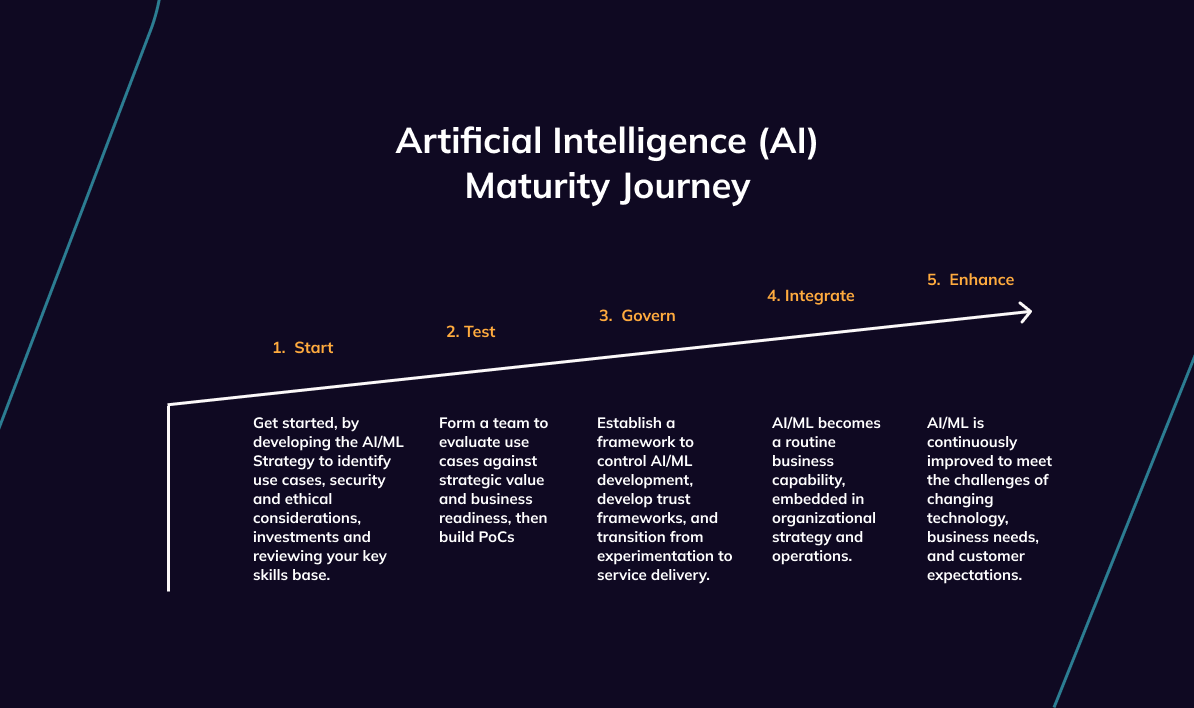
Why
Artificial Intelligence (AI) and Machine Learning (ML) have become buzzwords in today's digital landscape. Many organisations are keen to harness the power of these technologies to gain a competitive edge, drive innovation or to deliver better more efficient services. However, embarking on an AI/ML journey requires careful planning and consideration. So, what are the first steps to get started with AI/ML in your organisation, what are the potential barriers, and how do we delve into the process of developing effective use cases?
What
-
Understand the Benefits and Possibilities
Before diving into AI/ML implementation, it's crucial to have a clear understanding of the benefits and possibilities these technologies can offer. AI/ML can automate repetitive tasks, analyse vast amounts of data, make predictions, optimise processes, enhance customer experiences, and uncover valuable insights. What are the challenges in your world that could benefit from these types of capabilities? -
Define Your Objectives
Identify specific goals and objectives for incorporating AI/ML in your organisation. Start with your business strategy and key outcomes, what would address your strategic pain points or areas that could benefit from improved efficiency, cost reduction, or enhanced decision-making. Clearly defining objectives will guide your AI/ML strategy and help determine the resources, expertise, and investment required. -
Assess Data Availability and Quality
Data is the lifeblood of AI/ML. Evaluate the quality of your organisation's data. Identify potential gaps and areas that require improvement. Ensure data is accurate, relevant, and available to train AI models effectively. Invest in data management practices, data governance frameworks, and data infrastructure to ensure high-quality data is readily accessible. -
Cultivate AI/ML Capability
Building a successful AI/ML practice requires talent with expertise in data science, machine learning, trust frameworks and related fields. Assess your organisation's existing capabilities and identify skill gaps. Develop strategies to attract, hire, or upskill talent in AI/ML. Encourage cross-functional collaboration and knowledge-sharing to foster a data-driven culture within your organisation. -
Overcome Technical Barriers
AI/ML implementation often comes with technical challenges. Evaluate your organisation's existing technology infrastructure, including computational resources and cloud capabilities. Consider scalability, security, and data privacy concerns when selecting AI/ML tools and platforms. Collaborate with IT teams to ensure compatibility, address any technical limitations, and create a robust foundation for AI/ML initiatives. -
Start with Low-Hanging Fruit
To gain momentum and demonstrate the value of AI/ML, begin with smaller, manageable projects that align with your defined organisational objectives. Focus on use cases that offer quick wins and tangible benefits. By starting small, you can minimise risks, learn from initial successes and failures, and gradually scale up your AI/ML initiatives. -
Foster Collaboration and Feedback Loops:
Successful AI/ML implementation requires collaboration among various teams, including business stakeholders, data specialists, IT, and end-users. Establish feedback loops to continuously refine and improve AI/ML models based on real-world outcomes. Encourage an iterative approach to development, allowing for flexibility and adaptation as insights are gained from user feedback.
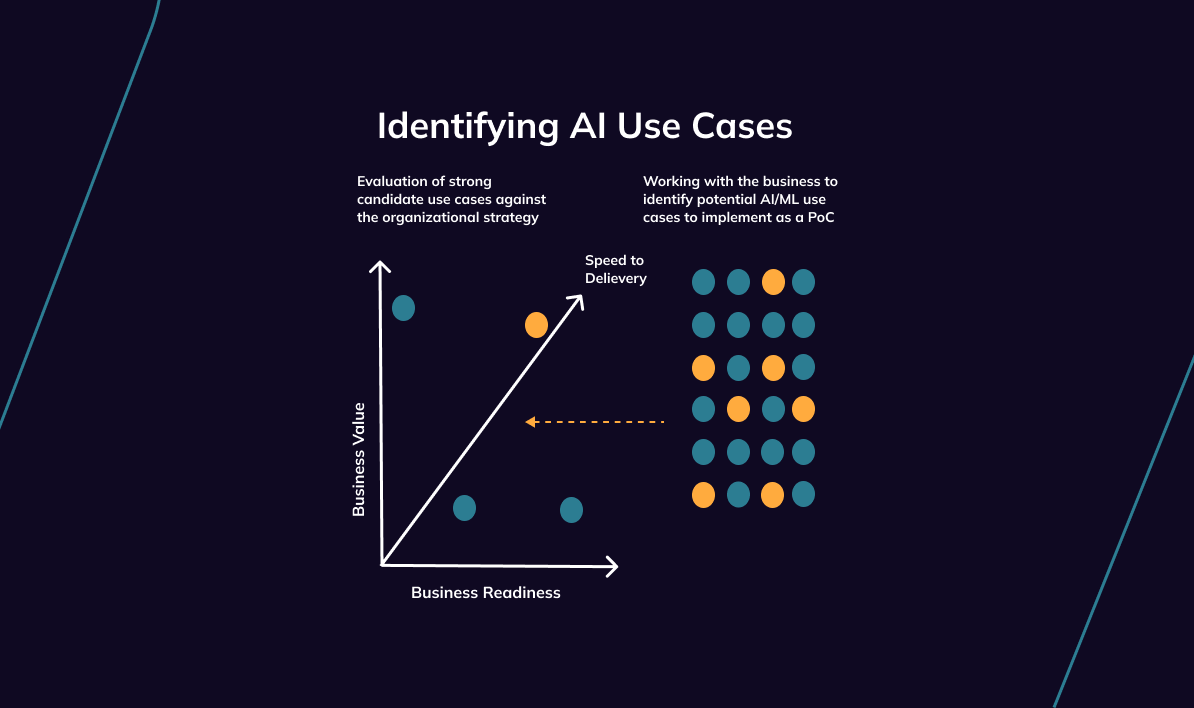
Outcome
Integrating AI/ML into your organisation's operations is a journey that requires planning, data readiness, capability acquisition, and strategic use case development. By understanding the benefits, addressing potential risks and barriers, and starting with manageable projects, you can pave the way for successful AI/ML adoption. Embrace the power of these technologies to unlock new opportunities, drive innovation, and stay ahead in today's data-driven world.
How?
VedArc has the capability to help you to take those key first steps. Contact us for an obligation free initial consultation at: partner@vedarc.cloud
Managed Architecture Services – addressing the skills shortage
Principal Partner - March 2023

Why
Architecture is a critical component of your transformation plan. Architecture for the cloud is where your business vision and operating model will be translated to cloud-oriented design patterns that guide the transformation of systems to your target state. With good design, governance of delivery can sequence your change projects along deliberate roadmaps that underpin your transformation.
Unfortunately, the importance of this function is matched by the scarcity of experienced cloud enterprise architects. Further, the chronic supply shortage for a broad range of digital skills is set to remain for the medium term because:
- While borders are now open, it is faster for local talent to take advantage of opportunities offshore than for migrants to enter the country productively – the result is effectively a brain drain of departing IT skills
- The megatrends toward cloud-based services and solution outsourcing that are affecting enterprises and society for everything-as-a-service is fueling digital transformation and broad demand for digital skills
- The number of agencies and enterprises embarking on digital transformation journeys through the cloud is set to accelerate further with the growth in onshore hyperscale infrastructure
- Onshore hyperscale infrastructure will complete the suite of cloud deployment options available for agencies and enterprises but also make for a complex landscape of hybrid-multi-cloud solutions from the edge to public cloud – complexity that needs careful navigation, again growing demand for skills.
The impact of these factors on the market is to drive costs up, increase quality related risk, as well as slow timelines and attenuate the path to benefits and ROI.
What
To mitigate the risk to your transformation programme, you will need to be strategic and approach the issue creatively. Classical responses include:
- more attractive remuneration and packages for staff
- increased flexibility in working arrangements
- and increased training and active career path development to retain loyal talent.
An additional tactic is to source critical skills in new ways – as a service. Subscribing to cloud architectural services, or Managed Architectural Services (MAS), can give you access to senior, experienced talent at a more affordable cost without competing for the staff or carrying the overhead associated with direct employment. Sourcing through MAS can give you more flexibility in matching cost to benefit and skills to specific design challenges. Providers with a practice-based approach to MAS can also increase your confidence where they take responsibility for quality assurance and continuity. Unlike project based consultancy, your architectural influence can be maintained with design skills embedded from a flexible pool of resources; integrated into your operating model.
Outcome
MAS extends the everything-as-a-service notion to offer enterprises an additional option to address the issue of scarcity of critical architectural skills at this important time for transformation. Combined with a strategy for recruitment and training, this approach could help avoid resource based delays to achieving the outcomes sought from new cloud based models.
How?
If you would like to subscribe to MAS or obligation free initial consultation on VedArc services, then please reach out to partner@vedarc.cloud
Strategy & Architecture – Simplify and mature your architecture Eco-system
Principal Partner - March 2023
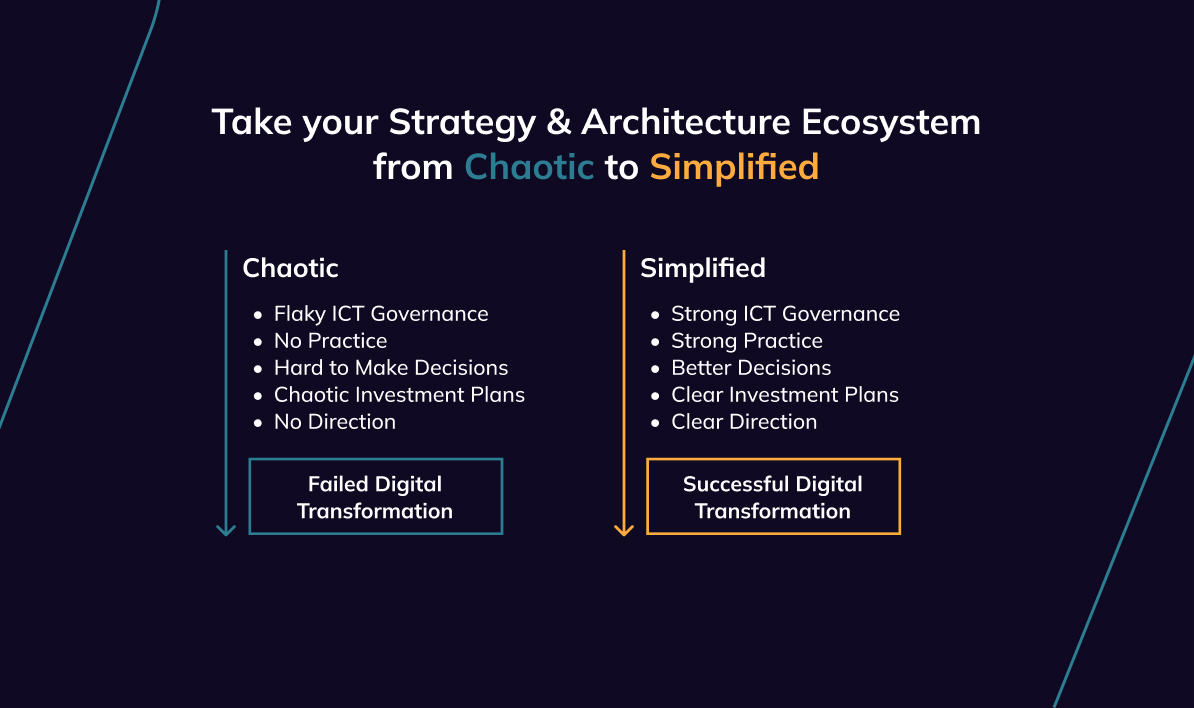
Why
Typically, organisations have a Strategy & Architecture practice, however, they could lack maturity from alignment and consumption perspectives. Following are some vital signs indicating the need to mature the Strategy and Architecture space:
- There is a lot of solution level activity and focus on tactical problems, but there is little or no longer-term view of the direction and end-state
- There is no strategic guiding roadmap for the projects to align
- There is a Governance practice, yet there is significant shadow IT activity
- There is an ICT strategy, but it is point in time and hence tricky for Projects to consume
- There is a Cloud Strategy, but you are not able to confidently scale your cloud journey
- Bringing about re-use across projects is proving difficult, so must start each project from a blank start
- Must use contracting resources often for “breathe in / breathe out” capacity, so enterprise IP gets lost when they walk out
- There is no central architectural repository, or it is woefully outdated or proving challenging to keep up to date. Therefore, it isn’t easy to maintain a holistic Enterprise view
- There is significant attrition and frustration in the EA space as a result of the above factors
What
Organisations typically have two to three distinct planning horizons to reflect different scope, update and review cycles. The respective strategies in these horizons are supported through cascading goals and continuous alignment. For example, Corporate Strategy provides a long-term and direction of travel-oriented view of the business. In support, the ICT Strategy aligns with this direction and provides a medium to a long-term plan of ICT transformation actions. This may require the ICT strategy to be split into multiple business-domain level sub-strategies, providing the forum and the basis for the engagement of business stakeholders for co-design purposes. The ICT Strategy/Sub-strategies can then be backed with a multi-year investment plan that describes the changes to the ICT architecture and systems.

Outcome
Such an approach provides a solid foundation to undertake and govern the execution of projects with a known and defined end state in mind. The Advanced Integrated RoadMap (AiR TM) brings the long and short-term ICT planning and investment views together to ensure a common understanding of ICT planning scope and priorities.
How?
If you would like to subscribe to MAS or obligation free initial consultation on VedArc services, then please reach out to partner@vedarc.cloud
Cloud Operating Model – Get the most value of cloud with the right operating model
Principal Partner - March 2023
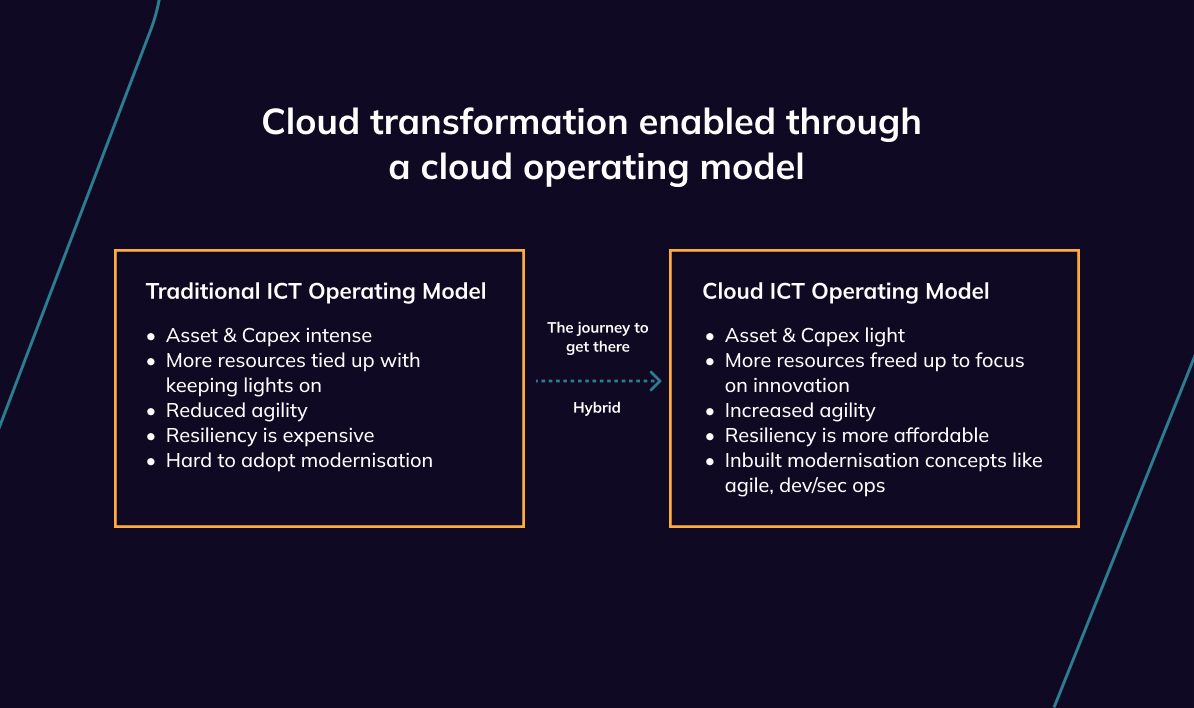
Why
Moving to the cloud is increasingly becoming a top priority for organisations. However, it can be challenging to leverage the cloud's strategic benefits and scale adoption fully. This is often due to the existing IT operating model being stuck in traditional processes and technologies, which don't align well with the agile nature of the cloud. To capture the true value of the cloud, it is essential to change how IT works and collaborates with the business. A framework can provide a structured path to design and develop the configuration of the future cloud operating model journey.
What
The journey to a cloud operating model is as important as the destination. It starts with understanding where your organisation stands in its cloud journey and determining the right destination. If you're starting, a good initial step could be introducing a new cloud capability within your existing hybrid IT model (a combination of cloud and traditional IT). This helps build momentum and gain support from key stakeholders. For example, you can begin with productivity services like Office365 before moving on to more complex business applications. However, broader business and IT staff buy-in may still pose a challenge. To ensure success, you need a cloud strategy outlining the business drivers and benefits, along with a realistic roadmap that includes risk assessment and investment planning. If you're further along in your journey, a more transformative change to the operating model may be necessary to fully realise the business value of the cloud. This may involve role changes and restructuring to embed cloud principles into the teams and re-imagining your Operating Model to align with your Cloud Adoption Framework.
Outcome
The goal is to have an operating model that guides agencies in modernising their people, processes, and technology capabilities in the ICT Application and Operations functions. This alignment with the Cloud Strategy allows for confident scaling of the cloud journey, realising anticipated benefits, and effective management of security risks and cloud costs.
How?
If you would like to subscribe to MAS or obligation free initial consultation on VedArc services, then please reach out to partner@vedarc.cloud
Cybersecurity – Unlock your cybersecurity architecture potential
Principal Partner - March 2023
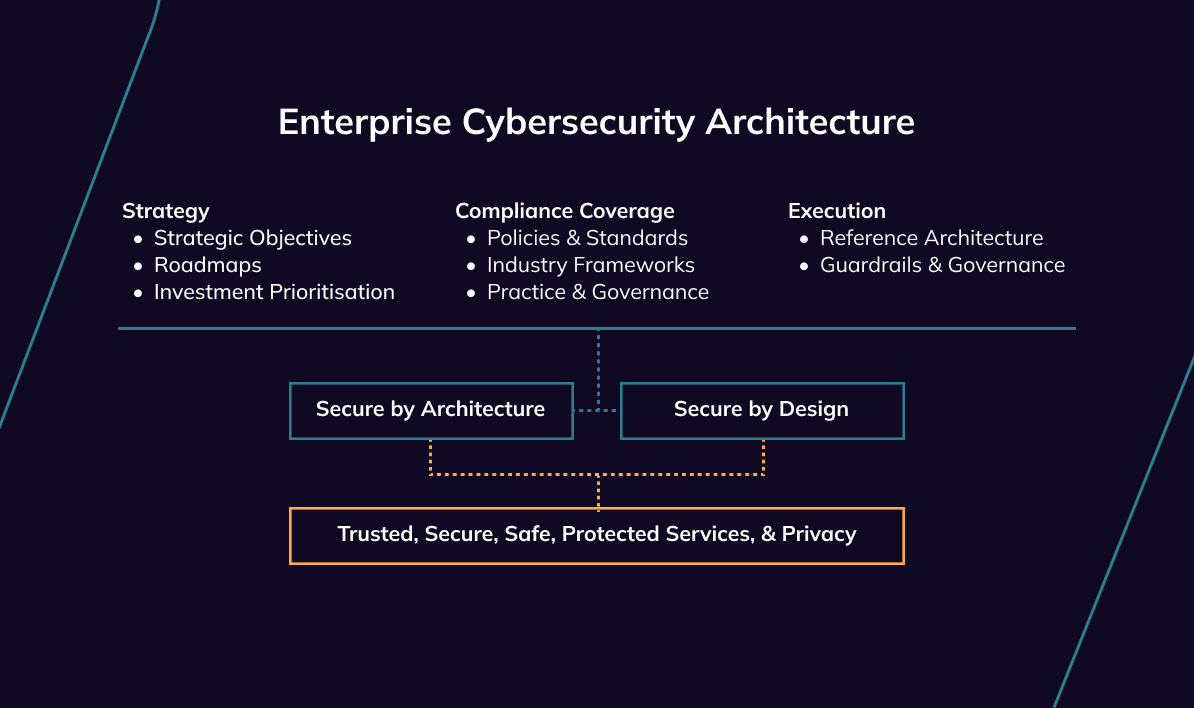
Why
An effective cybersecurity practice that is driven by and connects with business outcomes provides a foundation platform to maintain a managed state of risk. Many organisations have a lack of ownership in managing cybersecurity risks leading to sub-optimal investments . Having a robust cybersecurity practice that aligns with business objectives is critical for achieving a secure and stable risk posture. Unfortunately, numerous organisations fall short in taking ownership of their cybersecurity risks, which often results in inadequate investments and a compromised security posture.
What
Cybersecurity practice brings about enterprise security architecture through the business alignment of security measures with business objectives. It focuses on three major components: Strategy, Governance and Technology Architecture. The main goal is to support risk management functions in the business by minimising the probability and impact of cybersecurity risk. It provides traceability and justification by defining relationships between various architectural components .
A security practice/program is established to support and oversee enterprise security requirements. This informs security investments to be prioritised to meet the organisational risk appetite.
A mature Enterprise Security Architecture practice typically includes the following set of elements:
Strategy – Set direction and inform investment by helping the business understand current and future state requirements and developing strategic objectives and roadmaps, which informs strategic and risk-based investment prioritisation.
Governance – Adopt and maintain cybersecurity principles, policies, standards, frameworks, guidelines and processes.
Technology Architecture – Guide consistent, safe and secure solutions using reference architectures, principles, policies, standards, guidelines and processes.
Outcome
A cybersecurity practice capability that is adaptable, forward-thinking, and continuously evolving to bridge the gap between business objectives and technical necessities .
This enables the business to make informed short and long-term investments in effective cybersecurity controls to mitigate cybersecurity risks.
The benefits of a strong cybersecurity architecture practice include:
- Strong security architecture leads to fewer security breaches.
- Strategic and proactive security measures reduce risk and save money.
- Mitigate financial and reputational impact during a breach.
How?
If you would like to subscribe to MAS or obligation free initial consultation on VedArc services, then please reach out to partner@vedarc.cloud
A new era is dawning for digital identity.
Principal Partner - July 2023

Adapted from original diagram by DIA
Why
The term "Digital identity" has already generated too much debate over its meaning so let's go with the official definition What is digital identity? | NZ Digital government and get on with what this means for you. This concept is becoming increasingly important but has proven achingly difficult to improve for people. Identification and authentication of customers is not done well. It never has been as it was omitted from the very design of the internet. It involves processes tainted by outdated paradigms such as gathering and holding customer data for profiling and targeting. This has led to over collection, privacy breaches, poor experience, and customer disenfranchisement. And with the constant threat of fraudulent misrepresentation using people’s data, we no longer feel in control of our own identities. This is also in the face of increasing challenge from misuse of artificial intelligence to knowledge-based approaches. Where is the trust?
What
New Zealand’s Digital Identity Services Trust Framework is now law in NZ and in the process of being operationalized through a regulator. This change really is opportunity – a game changer for our digital economy and society. What does this mean for your agency? Are you ready to take advantage? Will you be a source of information for people to share as credentials? Will you be able to consume credentials – reducing your risk, while increasing your efficiency and customer experience?
Outcome
With modern approaches to digital services, people and enterprises can both enjoy better access, higher security, stronger resilience and richer insight – through a more balanced relationship. People will be able to access the services they are entitled or authorized to without oversharing, and with confidence they can trust the services they are using. Organizations can also trust the evidence they receive and no longer hold personal information unnecessarily – a toxic asset.
How?
VedArc has people that helped architect the very ecosystem that the Trust Framework represents. We can help you understand it and the implications for your customer and user management. partner@vedarc.cloud
